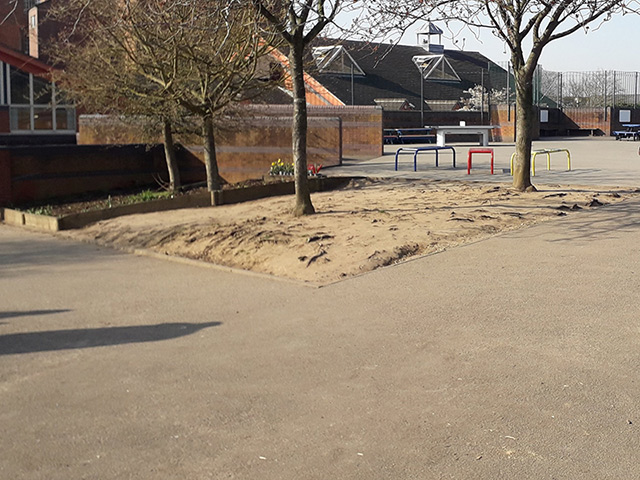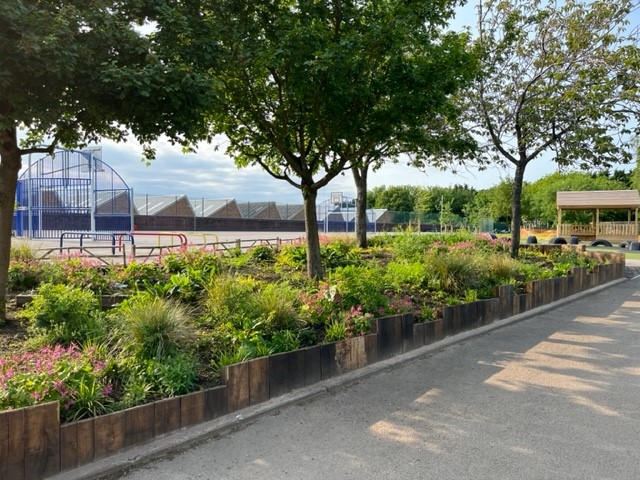Sustainable drainage systems in schools
We secured over £100,000 worth of funding to deliver SuDS (sustainable drainage systems) in schools to minimise flash flooding from surface water and improved resilience to climate change.
Quick links
What are SuDS?
SuDS are drainage systems that are environmentally beneficial, causing minimal or no long-term detrimental damage to the environment. SuDS mimic nature and manage rainfall close to where it falls.
SuDS are designed to:
- move surface water
- store surface water
- allow surface water to soak into the ground
- encourage surface water to evaporate (and transpire from vegetation)
SuDS also offer a wide variety of other benefits such as:
- improving facilities and biodiversity through habitat creation
- improve water quality
- provide attractive recreation spaces
- air quality improvements
- temperature moderation through shading
- mental health, wellbeing and educational benefits.
Why are SuDS needed in schools?
Climate change is leading to more severe and more frequent storm events, which is causing increased rainfall over shorter periods of time. This is overwhelming drainage systems (drains, gullies and sewers) and saturating our natural surfaces leading to the accumulation of surface water.
As a result, this leads to flash flooding from surface water as water cannot drain away. This is particularly an issue within schools due to their large amounts of hard surfaced areas, such as their playgrounds.
Schools involved in the project
The three schools involved in the project were selected based on their surface water flood risk and were:
- Abbey Mead Primary Academy – Belgrave Ward
- Linden Primary School – Evington Ward
- Bridge Junior School – North Evington Ward
Breakdown of project funding
The funding for the project came from several partners and was broken down as follows:
- Department for Education - £56,000
- Trees for Cities - £24,000
- Severn Trent Water - £20,000
- Leicester City Council - £13,000
What was the aim of the project?
The aim of the project was to:
- Retrofit innovative SuDS in three schools to minimise flooding from surface water and improve each school’s resilience to changing climate and other benefits
- Deliver a dedicated education programme to raise awareness of; climate change and extreme weather events (storms, droughts and flooding), the importance of SuDS and how these can be used to manage flash flooding from surface water and the wider benefits SuDS offer.
What did the project involve?
We designed, constructed and implemented 15 innovative SuDS at the 3 schools involved in the project (5 SuDS at each school) which took the form of; rain gardens, rainwater planters, swales, storage basins, green rooves, filter drains and wildlife areas (hibernacula’s, bug hotels and small mammal habitats). The SuDS reduce the chance of flash flooding from surface water and improve each school’s resilience to changing climate.
The SuDS also provide; green space improvements in our school grounds, promoting an increase in biodiversity and helping students reconnect with nature. Whilst creating quality education and recreation spaces, improving air quality and providing a wealth of other health and wellbeing benefits.
For further information on SuDS visit: susdrain.org.
A bespoke designed four-part education programme was delivered to over 500 students across all three schools (focusing on Years 3 – 5).
Each session covered a new topic and these increased awareness of; climate change, the impacts that this has on extreme weather events (storms, droughts and flooding), the importance of SuDS (Sustainable Drainage System) in the management of these extreme weather events and prevention of flooding. As well as, highlighting all the added benefits SuDS provide in our schools and wider community.
Students also developed practical skills during each of the sessions accompanying activities. The topics covered also linked to elements science, geography and mathematics curriculum.
The project ran from September 2023 to March 2023 and was structured as follows:
- Grant application - June 2022 to August 2022
- Design - September 2022 to November 2022
- Construction - November 2022 to March 2023
- Education - December 2022 to March 2023
What was successful about the project?
There were several successes associated with the project and these are summarised below:
- 15 innovative SuDS were constructed on time and on budget
- education programme was delivered to over 500 students
- biodiversity and ecology have been improved at each of the schools
- unique recreational and education spaces have been created
- supported each of the school's obligations under eco-schools and contributed to each attaining/keeping green flag status
- students have been empowered; they have been involved in the design and maintenance of the SuDS within their school
- overwhelming positive feedback received from all schools that took part in the project – from Head teachers, teachers, business management/premises staff and students
- developed professional working relationship with partner organisations that can be applied to future projects
- Inspired other local authorities to undertake SuDS in schools, such as Leicestershire County Council and Nottingham City Council.
Challenges
There were several challenges experienced during the project and these are summarised below:
- Each school had restricted access to parts of their grounds, which introduced difficulties for our contractor on material deliveries and operation of plant (vehicles and equipment)
- Timescales associated with the project were constrained due to the nature of funding, meaning in case of delays there was very little extra time available
- Internal processes at the council associated with design, procurement and legal services led to delays that could be avoided in the future
- Operating a project with many partnership organisations led to difficulties due to conflicting priorities or varying timescales
- All works associated with the project were claimed in arrears, which meant all work was done at the expense of the council until grant, partnership and sponsorship agreements were signed and approved by the respective partner organisation
Example of SuDS – before and after
Before

After

Conclusion
Due to the project’s success, we are exploring how similar SuDS in schools projects can be undertaken at other local authority schools within the city of Leicester from 2024 onwards.
This section presents further information on the project organisations – their responsibilities and links to their websites for further information:
- Leicester City Council - Partnership Funding, design, project management and education at Linden Primary School and Bridge Junior School
- DfE (Department for Education) – Partnership funding and project support
- STW (Severn Trent Water) – Partnership Funding and project support
- Trees for Cities (Charitable Organisation) – Partnership Funding, design, project management and education at Abbey Mead Primary Academy
- Wildscapes Co-operative (Contractor) - responsible for construction of SuDS